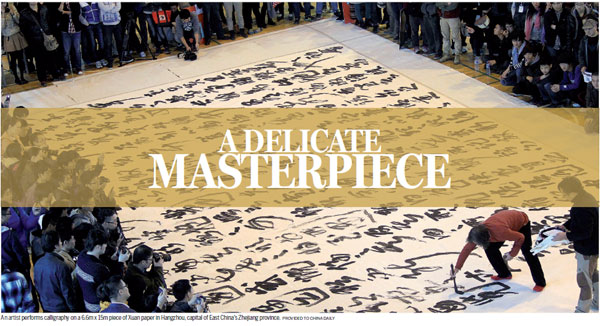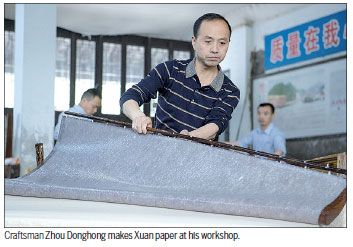A delicate masterpiece

While Xuan paper, the canvas that Chinese paintings and calligraphy are done on, may not be entirely relevant in today's era, it is actually as valued as the art on it
Zhou Donghong and his business partner of more than two decades are standing opposite one another with a vat of milky water between them.
They soon dip a rectangular wooden frame with a bamboo mat into the vat before pulling it out less than five seconds later. The move, which was rhythmic, graceful and done in perfect synchronization, resulted in excess water splashing over the sides of the vat, turning the mat on the frame into a massive damp handkerchief with a pale yellow sheen.
The frame is then plunged back in once more, but this time it emerges with pulp that is required to create what is considered China's finest paper - Xuan paper.
"It's like fishing the moon out of the water," said Zhou, quoting the Chinese proverb used to describe efforts made in vain.
In this context, however, he was describing how hard it is to perform such a task. The 51-year-old carefully peeled the pulp off the frame before stacking it on a trailer. The pulp will then undergo a few more processes before it can be turned into paper.
It takes at least three years to create a single sheet of Xuan paper. Much of the time is spent drying the sandal barks and rice straws in the sun.
"This has been pretty much how it has been done since it was invented. It's all by hand and has to be done by hand," he said.
Xuan paper was invented more than 1,500 years ago in Jingxian county, East China's Anhui province, where Zhou was born. He has spent most of his life trying to perfect the art of papermaking, and this particular step, which is called "paper fishing", is regarded as one of the trickiest steps in the whole process. There are 108 steps in total.

Zhou is a master craftsman at China Xuan Paper Corporation, the country's largest manufacturer of the paper. He has worked as a "paper fisher" for the past 30 years and is so skilled that his margin for error is within one gram.
"I use my hands as a scale. With just one shake I can feel the weight (of the pulp)," he said.
Restricted by the scarcity of raw materials, such as blue sandalwood that is believed to be indigenous to China, the country has been producing a steady amount of 800 tons of Xuan paper every year over the past decade. Up to 80 percent of the paper is made by China Xuan Paper Corporation. It carries the brand Hong Xing, or Red Star.
While most Chinese generally refer to Xuan paper as the material used for calligraphy and ink paintings, natives of Jingxian county view it differently - only those made in the county and from blue sandalwood qualify. They explain that the unique climate and water in the area gives the paper a distinctive flexibility and durability that outshines those made using other materials.
Dubbed as the "King of Paper" because it can last for centuries and is highly resistant against creasing, corrosion and mold, Xuan paper gained its name from its birthplace - Xuanzhou prefecture in the Tang Dynasty (AD 618-907). It first came into being five centuries after China invented paper and was presented as a tribute to the emperor.
Along with writing brushes, ink sticks and ink slabs, it used to be considered one of the four treasures for those who could write. In this digital era, however, Xuan paper has lost its relevance and is now deemed as an artwork and collectible that is as valuable as the paintings and writings on it.
The latest craze for the paper can be traced back to 2009, the year after the Beijing Olympic Games during which a massive scroll of Xuan paper, painted with Chinese mountains in black and white, was featured at the opening ceremony. That same year, the papermaking process was listed as a world intangible culture heritage by UNESCO.
Around 2012 when the craze peaked, a stack of 100 sheets of Xuan paper which weighed about 3 kilograms, transacted at 3,000 yuan ($435). Vintage paper, considered those that are more than five years old, could be auctioned at 15,000 yuan, pricier than gold of the same weight.
Like most collectibles, the craze waned after 2013 when the nation introduced a strict anti-corruption campaign that banned any forms of luxury banqueting and gifting.
Today, an regular stack of Xuan paper retails for 1,800 yuan.
Though the demand for gifting has experienced a sharp decline, the days of Xuan paper are far from numbered. A growing number of nouveau rich in the country have been picking up calligraphy which, like drinking tea and practicing taichi, has been viewed as a means of restoring inner peace.
Furthermore, in response to the call by President Xi Jinping to revive Chinese traditional culture so as to consolidate national confidence, an increasing number of primary schools in big cities like Shanghai and Beijing have also been introducing optional calligraphy and Chinese ink painting lessons to their students.
"Xuan paper might be considered the Lafite in the world of paper, used only by master painters and calligraphy writers," said Wu Zhangqian, spokesman of China Xuan Paper Corporation. "But the more potential users, the better."
Founded in 1951 following a merger between scores of family-style mills in the county, the State-owned company is now staffed by more than 1,300 employees and covers an area of about 3 square kilometers. It is located between two valleys where a creek called Wuxi runs through. This creek is the main water supply for the industry.
Zhou was raised in a family of farmers. He was led to the paper mill in the summer of 1985 after his attempt to become a carpenter failed. The working environment of a paper fisher, which featured cool water and air, was attractive to him as it offered him "the illusion of working in an air-conditioned room".
"Had I gone there in winter or been offered the position of a paper dryer who has to work by a steam-heated wall at a temperature of 70 degrees Celsius all year long, it might have been a completely different story," he recalled.
Zhou produces 1,000 sheets of Xuan paper every day. Unlike master craftsmen who make paint brushes or ink sticks, his name is never seen on the finished product. However, he can take pride in knowing that some of the country's most celebrated artists only buy paper from the factory that is made by him.
In 2015, Zhou was named as one of China's eight national craftsmen, alongside the engineer who builds China's high-speed trains and the technician who welds the nation's Long March V carrier rocket. But Zhou is hesitant to claim all the credit.
"It is a collective work of hundreds of people. No matter how skilled one is at his craft, he alone cannot produce a sheet of Xuan paper," he said.
His wife, Zhang Xiaoxia, also works at China Xuan Paper Corporation. Her job involves spotting clumps or impurities on the translucent paper. Those that fail the inspection are destroyed.
"My wife not only finds fault with me at home, but also at work," joked Zhou.
xujunqian@chinadaily.com.cn



(China Daily USA 05/05/2017 page9)
Today's Top News
- Xi encourages young sinologists to bridge China, the world
- Xi, president of Comoros exchange congratulations on 50th anniversary of ties
- Luxury leasing market gains traction in HK
- Historic games forge deeper bonds beyond podium
- Technology will ensure future heroes save lives and live
- Auto market rides high on NEV sales growth






























